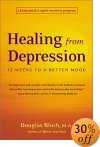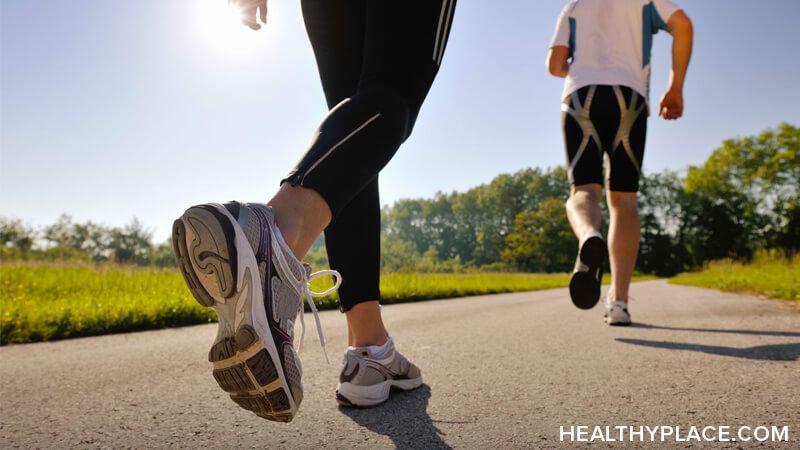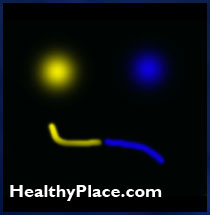THE NATURE OF THE TROUBLE AND THE FORMS OF HELP
What Does "Depression" Mean?
 The term "depression" means to psychiatrists and psychologists a continued state of mind with these central characteristics: (1) You are sad or "blue." (2) You have a low regard for yourself. In addition, (3) a sense of being helpless and hopeless is an integral part of the depression process. A variety of other symptoms such as poor sleep may or may not accompany these two core symptoms. They are not central to the depression.
The term "depression" means to psychiatrists and psychologists a continued state of mind with these central characteristics: (1) You are sad or "blue." (2) You have a low regard for yourself. In addition, (3) a sense of being helpless and hopeless is an integral part of the depression process. A variety of other symptoms such as poor sleep may or may not accompany these two core symptoms. They are not central to the depression.
Sadness is not equivalent to depression, and not all sadness is pathological. Everyone is sad from time to time, sometimes in response to genuinely sad events such as the loss of a loved one. The sadness that follows such a loss is natural and even necessary, and should be accepted as such. Unless the sadness continues un-normally -- that is, continues so long that it disturbs a person's life, and the person feels that there is something wrong -- the label "depression" does not apply. But if the sadness does continue un-normally, and then picks up a feeling of worthlessness as a companion and turns into a prolonged state, the condition then becomes an enemy to be fought.
Very occasionally there may be some doubt about whether to call a person "depressed", especially when sadness continues for a long time after a tragic death. In such a case, the person may not feel worthless. But almost always depression is clear-cut, though the depth of depression may vary.
Sadness is caused by the mechanism which will be described shortly. If you understand and manipulate the mechanism properly, you can get rid of the sadness. The depression mechanism does not by itself produce or explain low self-regard. But if you operate the mechanism appropriately, you are likely to get rid of the low self-regard, too, and at the least you will not be preoccupied with it and ravaged by it.
This is the mechanism which causes the sadness in depression: Whenever you think about yourself in a judgmental fashion--which most of us frequently do--your thought takes the form of a comparison between a) the state you think you are in (including your skills and capacities) and b) some other hypothetical "benchmark" state of affairs. The benchmark situation may be the state you think you ought to be in, or the state you formerly were in, or the state you expected or hoped to be in, or the state you aspire to achieve, or the state someone else told you you must achieve. This comparison between actual and hypothetical states makes you feel bad if the state in which you think you are in is less positive than the state you compare yourself to. And the bad mood will become a sad mood rather than an angry or determined mood if you also feel helpless to improve your actual state of affairs or to change your benchmark.
We can write the comparison formally as a Mood Ratio:
Mood=(Perceived state of oneself) (Hypothetical benchmark state)
If the numerator (perceived state of oneself) in the Mood Ratio is low compared to the denominator (hypothetical benchmark state) --a situation which I'll call a Rotten Ratio--your mood will be bad. If on the contrary the numerator is high compared to the denominator--a state which I'll call a Rosy Ratio--your mood will be good. If your Mood Ratio is Rotten and you feel helpless to change it, you will feel sad. Eventually you will be depressed if a Rotten Ratio and a helpless attitude continue to dominate your thinking. This precise formulation constitutes a new theoretical understanding of depression.
The comparison you make at a given moment may concern any one of many possible personal characteristics--your occupational success, your personal relationships, your state of health, or your morality, for just a few examples. Or you may compare yourself on several different characteristics from time to time.
If the bulk of your self-comparison thoughts are negative over a sustained period of time, and you feel helpless to change them, you will be depressed. Check yourself and you will observe in your mind such a negative self-comparison ("neg-comp" for short) when you feel bad, whether or not the sadness is part of a general depression.
Only with this Self-Comparisons Analysis can we make sense of such exceptional cases as the person who is poor in the world's goods but nevertheless is happy, and the person who "has everything" but is miserable; not only do their actual situations affect their feelings, but also the benchmark comparisons they set up for themselves.
The sense of loss, which often is associated with the onset of depression, also can be seen as a negative self-comparison (neg-comp) -- a comparison between the way things were before the loss, and the way they are after the loss. A person who never had a fortune does not experience the loss of a fortune in a stock market crash and therefore cannot suffer grief and depression from losing it. Losses that are irreversible, such as the death of a loved one, are particularly saddening because you are helpless to do anything about the comparison. But the concept of comparisons is a more fundamental logical element in thought processes than is loss, and therefore it is a more powerful engine of analysis and treatment.
The key element for understanding and dealing with depression, then, is the sadness-producing negative comparison between one's actual state and one's benchmark hypothetical situation, together with the attitude of helplessness as well as the conditions that lead a person to make such comparisons frequently and acutely.
Now we are ready to ask: How can you manipulate your mental apparatus so as to prevent the flow of negative self-comparisons about which you feel helpless? There are several possibilities for any given person, and any one method may be successful for you. Or perhaps some combination of methods will prove best for you. The possibilities include: changing the numerator in the Mood Ratio; changing the denominator; changing the dimensions upon which you compare yourself; making no comparisons at all; reducing your sense of helplessness about changing the situation; and using one or more of your most cherished values as an engine to propel you out of your depression. Sometimes a powerful way to break a logjam in your thinking is to get rid of some of your "oughts" and "musts", and recognize that you do not need to make the negative comparisons that have been causing your sadness. I'll say a few words about each possibility now, and I'll discuss each general tactic at length later in the book.
Improving Your Numerator
Are you actually in as bad shape as you think you are? If you have an incorrect unflattering picture of some aspects of yourself that you consider important, then your self-comparison ratio will be erroneously negative. That is, if you systematically bias your estimate of yourself in a manner that makes you seem to yourself objectively worse than you really are, then you invite needless negative self-comparisons and depression.
We are talking about assessments of yourself that can be checked objectively. An example: Samuel G. complained that he was a consistent "loser" at everything he did. His counselor knew that he played ping pong, and asked him whether he usually won or lost at ping pong. Sam said that he usually lost. The counselor asked him to keep a record of the games he played in the following week. The record showed that Sam won a bit more often than he lost, which surprised Sam. With that evidence in hand, he was receptive to the idea that he also was giving himself a short count in other areas of his life, and hence producing fallacious negative self-comparisons and a Rotten Ratio. If you can raise your numerator - if you can find yourself really to be a better person than you now think you are -you will make your self- comparisons more positive. By so doing you will reduce sadness, increase your good feelings, and fight depression.
Sweetening Your Denominator
When told that life is hard, Voltaire asked," Compared to what?" The denominator is the standard of comparison that you habitually measure yourself against. Whether your self- comparison appears favorable or unfavorable depends as much upon the denominator you use as upon the supposed facts of your own life. Standards of comparison include what you hope to be, what you formerly were, what you think you ought to be, or others to whom you compare yourself.
"Normal" people--that is, people who do not get depressed frequently or for a long time--alter their denominators flexibly. Their procedure is: choose the denominator that will make you feel good about yourself. Psychologically-normal tennis players choose opponents who provide an even match--strong enough to provide invigorating competition, but sufficiently weak so you can often feel successful. The depressive personality, on the other hand, may pick an opponent so strong that the depressive almost always gets beaten. (A person with another sort of problem picks an opponent who is so weak that he or she provides no exciting competition.)
In the more important life situations, however, it is not as easy as in tennis to choose a well-fitting denominator as the standard of comparison. A boy who is physically weak and unathletic relative to his grammar-school classmates is stuck with that fact. So is the child who is slow at learning arithmetic, and the homely girl. A death of a spouse or child or parent is another fact which one cannot deal with as flexibly as one can change tennis partners.
Though the denominator that stares you in the face may be a simple fact, you are not chained to it with unbreakable shackles. Misery is not your inexorable fate. People can change schools, start new families, or retrain themselves for occupations that fit them better than the old ones. Others find ways to accept difficult facts as facts, and to alter their thinking so that the unpleasing facts cease causing distress. But some people--people we call "depressives"--do not manage to free themselves from denominators that hag-ride them into depression, or even unto death by suicide or other depression-caused diseases.
Why do some people appropriately adjust their denominators while others do not? Some do not change their denominators because they lack experience or imagination or flexibility to consider other relevant possibilities. For example, until he got some professional career advice, Joe T. had never even considered an occupation in which his talent later enabled him to succeed, after failing in his previous occupation.
Other people are stuck with pain-causing denominators because they have somehow acquired the idea that they must meet the standards of those pain-causing denominators. Often this is the legacy of parents who insisted that unless the child would reach certain particular goals--say, a Nobel prize, or becoming a millionaire--the child should consider himself or herself a failure in the parent's eyes. The person may never realize that it is not necessary that she or he accept as valid those goals set by the parents. Instead, the person masturbates, in Ellis's memorable term (and note that Ellis has good words to say about masturbation). Ellis emphasizes the importance of getting rid of such unnecessary and damaging "oughts" as part of his Rational- Emotive variation of cognitive therapy.
Still others believe that attaining certain goals--curing others of illness, or making a lifesaving discovery, or raising several happy children--is a basic value in itself. They believe that one is not free to abandon the goal simply because it causes pain to the person who holds that goal.
Still others think that they ought to have a denominator so challenging that it stretches them to the utmost, and/or keeps them miserable. Just why they think that way is not usually clear to those persons. If they learn why they do so they often stop.
Chapter 13 describes a six step-procedure that can help you change your denominator to a more livable standard of comparison than the one which may now be depressing you.
New Dimensions and Better Ratios
If you can't make the old Mood Ratio rosy or even livable, then consider getting a new one. Folk wisdom is indeed wise in advising us to forcefully direct our attention to the good things in our lives instead of the bad things. Counting one's blessings is the common label for focusing on dimensions that will make us happy: remembering your good health when you lose your money; remembering your wonderful loving children when the job is a failure; remembering your good friends when a false friend betrays you, or when a friend dies; and so on. What folk wisdom does not tell you is that counting your blessings often is not easy to do. It can require great effort to keep your attention focused on your blessings and away from what you consider your curse.
Related to counting blessings is refusing to consider aspects of your situation which are beyond your control at the moment in order to avoid letting them distress you. This is commonly called "taking it one day at a time." If you are an alcoholic, you refuse to let yourself be depressed about the pain and difficulty of stopping drinking for the rest of your life, which you feel almost helpless to do. Instead, you focus on not drinking today, which seems a lot easier. If you have had a financial disaster, instead of regretting the past you might think about today's work to begin repairing your fortunes.
Taking it one day at a time does not mean that you fail to plan for tomorrow. It does mean that after you have done whatever planning is possible, you then forget about the potential dangers of the future, and focus on what you can do today. This is the core of such books of folk wisdom as Dale Carnegie's How to Stop Worrying and Start Living.9
Finding personal comparisons which make your Mood Ratio positive is the way that most people construct an image of themselves which makes them look good. The life strategy of the healthy-minded person is to find a dimension on which he or she performs relatively well, and then to argue to oneself and to others that it is the most important dimension on which to judge a person.
A 1954 popular song by Johnny Mercer and Harold Arlen went like this: "You've got to accentuate the positive...Eliminate the negative...Latch on to the affirmative...Don't mess with Mister In-between." That sums up how most normal people arrange their views of the world and themselves so that they have self-respect. This procedure can be unpleasant to other people, because the person who accentuates his or her own strengths may thereby accentuate what in other people is less positive. And the person often proclaims intolerantly that that dimension is the most important one of all. But this may be the price of self-respect and non-depression for some people. And often you can accentuate your own strengths without being offensive to others.
A more attractive illustration: appreciating your own courage is often an excellent way to shift dimensions. If you have been struggling without much success for years to convince the world that your fish-meal protein is an effective and cheap way of preventing protein-deficiency diseases in poor children (an actual case), you may be greatly saddened if you dwell on the comparison between what you have achieved and what you aspire to achieve. But if you focus instead upon your courage in making this brave fight, even in the face of the lack of success, then you will give yourself an honest and respectable positive comparison and a Mood Ratio which will make you feel happy rather than sad, and which will lead you to esteem yourself well rather than poorly.
Because of childhood experiences or because of their values, depressives tend not to be flexible in choosing dimensions that will make them look good. Yet depressives can successfully shift dimensions if they work at it. In addition to the ways mentioned above, which will be discussed at length in Chapter 14, there is still another -- and very radical -- way to shift dimensions. This is to make a determined effort -- even to demand of yourself -- in the name of some other value, that you shift from a dimension that is causing you grief. This is the core of Values Treatment which was crucial in curing my 13-year depression; more about this shortly.
The Sound of a Numerator Clapping
No self-comparisons, no sadness. No sadness, no depression. So why don't we just get rid of self-comparisons completely?
A practicing Zen Buddhist with an independent income and a grown family can get along without making many self-comparisons. But for those of us who must struggle to achieve our ends in the workaday world, some comparisons between what we and others do are necessary to keep us directed toward achieving these ends. Yet, if we try, we can successfully reduce the number of these comparisons by focusing our minds on other activities instead. We can also help ourselves by judging only our performances relative to the performances of others, rather than judging our very selves -- that is, our whole persons -- to others. Our performances are not the same as our persons.
Work that absorbs your attention is perhaps the most effective device for avoiding self-comparisons. When Einstein was asked how he dealt with the tragedies he suffered, he said something like: "Work, of course. What else is there?"
One of the best qualities of work is that it is usually available. And concentrating upon it requires no special discipline. While one is thinking about the task at hand, one's attention is effectively diverted from comparing oneself to some benchmark standard.
Another way to shut off self-comparisons is to care about other people's welfare, and to spend time helping them. This old-fashioned remedy against depression--altruism--has been the salvation of many.
Meditation is the traditional Oriental method of banishing negative self-comparisons. The essence of meditation is to shift to a special mode of concentrated thinking in which one does not evaluate or compare, but instead simply experiences the outer and inner sensory events as interesting but devoid of emotion. (In a less serious context this approach is called "inner tennis.")
Some Oriental religious practitioners seek the deepest and most continuous meditation in order to banish physical suffering as well as for religious purposes. But the same mechanism can be used while participating in everyday life as an effective weapon against negative self-comparisons and depression. Deep breathing is the first step in such meditation. All by itself, it can relax you and change your mood in the midst of a stream of negative self-comparisons.
We'll go into details later about the pro's and con's and procedures for various methods to avoid self-comparisons.
Getting Hope Back
Negative self-comparisons (neg-comps) by themselves do not make you sad. Instead, you may get angry, or you may mobilize yourself to change your life situation. But a helpless, hopeless attitude along with neg-comps leads to sadness and depression. This has even been shown in rat experiments. Rats that have experienced electric shocks which they cannot avoid later behave with less fight and more depression, with respect to electric shocks that they can avoid, than do rats that did not experience unavoidable shocks. The rats that experienced unavoidable shocks also show chemical changes like those associated with depression in humans.10
It behooves us, then, to consider how to avoid feeling helpless. One obvious answer in some situations is to realize that you are not helpless and you can change your actual state of affairs so that the comparison will be less negative. Sometimes this requires gradual re-learning through a graded series of tasks that show you that you can be successful, eventually leading to success in tasks that at the beginning seemed overwhelmingly difficult to you. This is the rationale of many behavioral-therapy programs that teach people to overcome their fears of elevators, heights, going out in public, and various social situations.
Indeed, the rats mentioned in the paragraph above, which learned to be helpless when given inescapable shocks, were later taught by experimenters to learn that they could escape the later shocks. They showed diminished chemical changes associated with depression after they had "unlearned" their original experiences.
Mitigating the helpless and hopeless attitude is discussed at greater length in Chapter 17.
A New Hope: Values Treatment
Let's say that you feel you're at the end of your rope. You believe that your numerator is accurate, and you see no appealing way to change your denominator or your dimensions of comparison. Avoiding all comparisons, or drastically reducing the quantity of them, does not attract you or does not seem feasible to you. You'd prefer not to be treated with anti-depression drugs or shock treatment unless there is absolutely no alternative. Is there any other possibility open to you?
Values Treatment may be able to rescue you from your end-of- the-rope desperation. For people who are less desperate, it may be preferable to other approaches to their depressions. The central element of Values Treatment is discovering within yourself a value or belief that conflicts with being depressed, or conflicts with some other belief (or value) that leads to the negative self-comparisons. That is how Bertrand Russell passed from a sad childhood to happy maturity in this fashion:
Now [after a miserably sad childhood] I enjoy life; I might almost say that with every year that passes I enjoy it more. This is due partly to having discovered what were the things that I most desired, and having gradually acquired many of these things. Partly it is due to having successfully dismissed certain objects of desire-- such as the acquisition of indubitable knowledge about something or other--as essentially unattainable.11
Values Treatment does exactly the opposite of trying to argue away the sadness-causing value. Instead it seeks a more powerful countervailing value to dominate the depression-causing forces. Here is how Values Treatment worked in my case: I discovered that my highest value is for my children to have a decent upbringing. A depressed father makes a terrible model for children. I therefore recognized that for their sake it was necessary to shift my self-comparisons from the occupational dimension that led to so many negative comparisons and sadness, and focus instead on our health and the enjoyment of the day's small delights. And it worked. I also discovered that I have an almost religious value for not wasting a human life in misery when it can possibly be lived in happiness. That value helped, too, working hand in hand with my value that my children not grow up having a depressed father.
That description makes the process seem much easier than it really is, of course. Focusing your mind upon your chosen values requires effort, often very great effort. Sometimes the required effort is so great that you cannot will yourself to make it, and instead you let yourself remain in the slough of despond. But the method of Values Treatment teaches you what has to be done, and gives you a reason for making the effort to do what must be done.
The depression-fighting value may be (as it was for me) the direct command that life should be joyful rather than sad. Or it may be a value that leads indirectly to a reduction in sadness, such as my value that my children should have a life-loving parent to imitate.
The discovered value may lead you to accept yourself for what you are, so that you can go on to other aspects of your life. A person with an emotionally-scarred childhood, or a polio patient confined to a wheelchair, may finally accept the situation as fact, cease railing at fate, and decide not to let the handicap dominate. The person may decide to pay attention instead to what he can contribute to others with a joyful spirit, or how he can be a good parent by being happy.
Values Treatment need not always proceed systematically. But a systematic procedure may be helpful to some people, and it makes clear which operations are important in Values Treatment. In Chapter 18 I'll describe such a systematic procedure for Values Treatment.
Is This Magic?
Please let's get this straight: This book, and cognitive therapy in general, do not offer you an instantly-working formula that will transport you from misery to bliss without the slightest effort or attention on your part. In order to transform yourself from being sad to being joyful you'll have to give the problem your attention and some hard work--whether you do the work alone or with the help of a professional counselor. The work includes writing down and analyzing your thoughts, a tedious but invaluable exercise. If you picked up this book looking for a while-you-wait no-sweat miracle, put it right back down again.
Nevertheless I do offer you "magic." I offer you a new analytic way of understanding your depression, upon which you can build a rational, successful procedure for extricating yourself from your unhappy jam. And the cure need not wait for long years of psychotherapy, dredging up the details of your past life and reliving it all. If you do choose to get outside help, ten or twenty sessions with a therapist are par for the course, and insurance often pays most of the cost.
This is not a guarantee that you will succeed with this method. But it is a promise that a speedy cure -- faster than nature's usual regenerative processes -- is possible for a large proportion of depression sufferers. Understanding aspects of your past life may be helpful in figuring out how to reconstruct your present mental life. But cognitive therapy focuses on the present structure of your thinking, and on changing that structure so that you can live with it joyfully, rather than simply proceeding to examine your history in the faith that such an examination will eventually produce a cure.
Though I believe that this book offers the most powerful methods for overcoming your depression, I recommend as strongly as I can that you read other books as well. The more you learn, the greater the chances that you will stumble across sentences or thoughts or anecdotes which will be just the right triggers for you to understand and cure your own depression. The best books for laymen, in my opinion, are David Burns's Feeling Good and Albert Ellis's and Robert Harper's A New Guide to Rational Living. Both contain lots of practical suggestions, as well as dialogues between therapists and depression sufferers which demonstrate the processes involved in dealing with depressed thinking. Your reading of those books will be even better if you bring to them the Self-comparisons Analysis discussed in this book. It will render the ideas in the other books more specific, and easier to understand and put to work. And after you have worked your way through one or both of those books, you might like to study some of the other books, including some intended for professionals, named in the reference at the end of their book.
You may also find crucial nuggets of wisdom in the aphorisms and anecdotes which fill popular self-help books. The common- sense ideas in those books would not live on from generation to generation they it did not help a substantial number of people from time to time.
Making yourself happy when you have been depressed is a great achievement. That achievement can make you proud of yourself in addition to the relief from pain and the new joy it brings. I wish you the same success and joy that I have had in using this method.
Summary
The term "depression" means a continued state of mind with these central characteristics: (1) You are sad or "blue." (2) You have a low regard for yourself. In addition, (3) a sense of being helpless and hopeless is an integral part of the depression process.
This mechanism causes the sadness in depression: Whenever you think about yourself in a judgmental fashion, your thought takes the form of a comparison between a) the state you think you are in (including your skills and capacities) and b) some other hypothetical "benchmark" state of affairs. The benchmark situation may be the state you think you ought to be in, or the state you formerly were in, or the state you expected or hoped to be in, or the state you aspire to achieve, or the state someone else told you you must achieve. This comparison between actual and hypothetical states makes you feel bad if the state in which you think you are in is less positive than the state you compare yourself to. And the bad mood will become a sad mood rather than an angry or determined mood if you also feel helpless to improve your actual state of affairs or to change your benchmark.
If you understand and manipulate the mechanism properly, you can get rid of the sadness. The depression mechanism does not by itself produce or explain low self-regard. But if you operate the mechanism appropriately, you are likely to get rid of the low self-regard, too, and at the least you will not be preoccupied with it and ravaged by it.
We can write the comparison formally as a Mood Ratio:
Mood=(Perceived__state__of__oneself) (Hypothetical benchmark state)
If the numerator (perceived state of oneself) in the Mood Ratio is low compared to the denominator (hypothetical benchmark state) --a situation which I'll call a Rotten Ratio--your mood will be bad. If on the contrary the numerator is high compared to the denominator--a state which I'll call a Rosy Ratio--your mood will be good. If your Mood Ratio is Rotten and you feel helpless to change it, you will feel sad. Eventually you will be depressed if a Rotten Ratio and a helpless attitude continue to dominate your thinking. This precise formulation constitutes a new theoretical understanding of depression.
The comparison you make at a given moment may concern any one of many possible personal characteristics--your occupational success, your personal relationships, your state of health, or your morality, for just a few examples. Or you may compare yourself on several different characteristics from time to time.
If the bulk of your self-comparison thoughts are negative over a sustained period of time, and you feel helpless to change them, you will be depressed.
There are several ways to manipulate your mental apparatus so as to prevent the flow of negative self-comparisons about which you feel helpless. The possibilities include: changing the numerator in the Mood Ratio; changing the denominator; changing the dimensions upon which you compare yourself; making no comparisons at all; reducing your sense of helplessness about changing the situation; and using one or more of your most cherished values as an engine to propel you out of your depression. Sometimes a powerful way to break a logjam in your thinking is to get rid of some of your "oughts" and "musts", and recognize that you do not need to make the negative comparisons that have been causing your sadness.
This book, and cognitive therapy in general, do not offer you an instantly-working formula that will transport you from misery to bliss without the slightest effort or attention on your part. In order to transform yourself from being sad to being joyful you'll have to give the problem your attention and some hard work--whether you do the work alone or with the help of a professional counselor.
The book does offer you a new analytic way of understanding your depression, upon which you can build a rational, successful procedure for extricating yourself from your unhappy jam. And the cure need not wait for long years of psychotherapy, dredging up the details of your past life and reliving it all. If you do choose to get outside help, ten or twenty sessions with a therapist are par for the course.
This is not a guarantee that you will succeed with this method. But it is a promise that a speedy cure -- faster than nature's usual regenerative processes -- is possible for a large proportion of depression sufferers.
*** Note:
Chapter 1 has summarized ideas found in Part I of the book, Chapters 2-9. If you are impatient to get to the self-help procedures in Part II Chapters 10 to 19), you can go directly from here to there, without pausing now to read further about the nature of depression and its elements. But if you have the patience to study a bit more before moving on to the the self-help procedures, it may be worth your while to read through Part I first. Or you can come back to Part II later.
The discussion in this book is pitched at a higher level of abstraction than are most self-help books. Partly this is because cognitive therapy requires somewhat more mental discipline, and more willingness to be introspective, than behavioral and other therapies.14 But the higher level is also partly due to the fact that the book is aimed at psychiatrists and psychologists, too, to present to them these new ideas and methods that render more powerful some ideas and procedures they are already familiar with. And these ideas can only be presented effectively to the professions in the context of working therapy rather than in a more rarefied and theoretical context.
next: Good Mood: The New Psychology of Overcoming Depression Chapter 3
~ back to Good Mood homepage
~ depression library articles
~ all articles on depression
 My depressions date back to early childhood. I can remember going to the guidance counselor's office in 6th grade begging for someone to help me because I felt so awfully sad. The feeling was just so overwhelming, I can't tell you how horrible it was. I just wanted to disappear from the earth altogether. Overwhelming sadness seems to have always been a part of my life since very early childhood.
My depressions date back to early childhood. I can remember going to the guidance counselor's office in 6th grade begging for someone to help me because I felt so awfully sad. The feeling was just so overwhelming, I can't tell you how horrible it was. I just wanted to disappear from the earth altogether. Overwhelming sadness seems to have always been a part of my life since very early childhood. As a partner, parent, child or friend of someone who is undergoing a depressive episode, here's how you can help the healing process.
As a partner, parent, child or friend of someone who is undergoing a depressive episode, here's how you can help the healing process.
 Dysmorphia is an obsessive-compulsive disorder that affects a person's perception of their body image. Most men who have this psychological illness are rather muscular when compared to the rest of the population, but they none-the-less wear baggy clothes and refuse to take their shirts off in public out of fear of being ridiculed because of their (anticipated) small size. It can be quite serious and needs to be treated. Dysmorphia might not have as direct an impact on a man's health as anorexia complications, but its repercussions can still have grave effects on a person's life. Some of the symptoms can cause irreparable damage to the body and the negative impact it can have on one's social life can take years to fix.
Dysmorphia is an obsessive-compulsive disorder that affects a person's perception of their body image. Most men who have this psychological illness are rather muscular when compared to the rest of the population, but they none-the-less wear baggy clothes and refuse to take their shirts off in public out of fear of being ridiculed because of their (anticipated) small size. It can be quite serious and needs to be treated. Dysmorphia might not have as direct an impact on a man's health as anorexia complications, but its repercussions can still have grave effects on a person's life. Some of the symptoms can cause irreparable damage to the body and the negative impact it can have on one's social life can take years to fix.
 The term "depression" means to psychiatrists and psychologists a continued state of mind with these central characteristics: (1) You are sad or "blue." (2) You have a low regard for yourself. In addition, (3) a sense of being helpless and hopeless is an integral part of the depression process. A variety of other symptoms such as poor sleep may or may not accompany these two core symptoms. They are not central to the depression.
The term "depression" means to psychiatrists and psychologists a continued state of mind with these central characteristics: (1) You are sad or "blue." (2) You have a low regard for yourself. In addition, (3) a sense of being helpless and hopeless is an integral part of the depression process. A variety of other symptoms such as poor sleep may or may not accompany these two core symptoms. They are not central to the depression. As has been mentioned several times above, the most effective tools available for the treatment of depression and bipolar disorder are medications (i.e. drugs). Nevertheless, many victims of these illnesses are often concerned and confused about taking medication, and therefore resist treatment.
As has been mentioned several times above, the most effective tools available for the treatment of depression and bipolar disorder are medications (i.e. drugs). Nevertheless, many victims of these illnesses are often concerned and confused about taking medication, and therefore resist treatment.